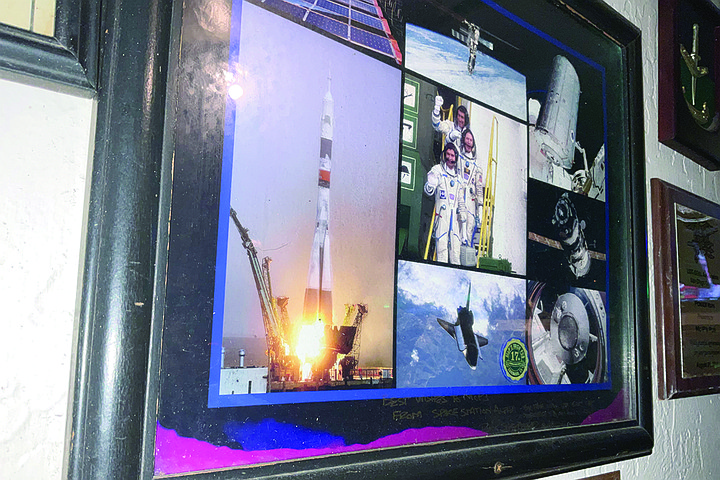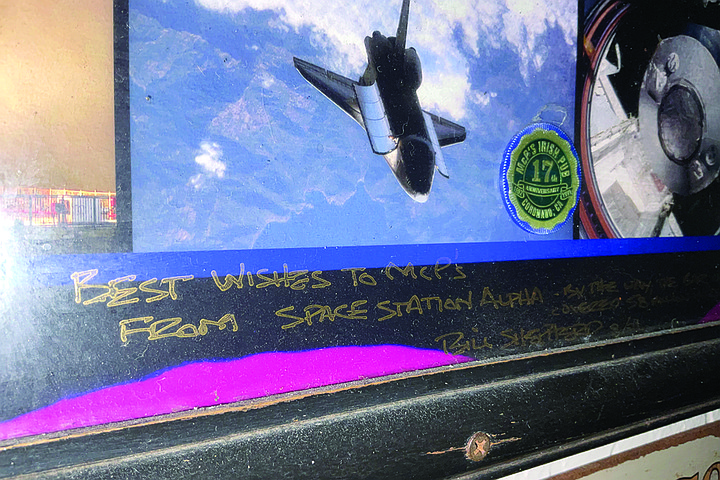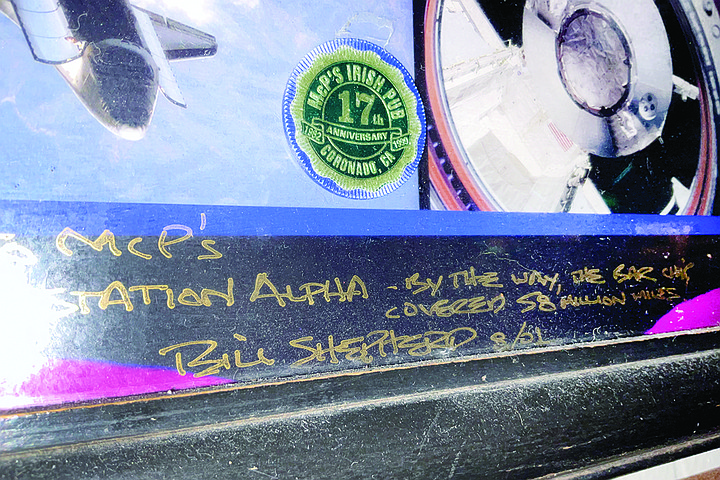 Facebook
Facebook
 X
X
 Instagram
Instagram
 TikTok
TikTok
 Youtube
Youtube

“I’m not super happy,” says the normally cheery astronaut Bill Shepherd. “It’s been 50 years, and we have not been back to the moon. We have three space shuttles that don’t fly any more, that are now in museums. These were vehicles that were not even in the middle of their operational life in terms of how much they could be used. They’re all shading places in the grass, in parking lots of museums or inside. I just wonder why we are stepping away from some of these advancements that we were willing to do decades ago.”
Shepherd has spent over five months in space, and now finds himself dismayed at the signs of atrophy he sees in the space industry. “San Diego used to be a hotbed of aerospace, building airplanes, big rockets. Yes, there are small companies that are doing manned vehicles, and robotics and things like that. But the big ambitious airplane and space programs? Supersonic transport? The SR-71 Blackbird? Saturn rockets? The Apollo moon mission? The list goes on and on. We have to be quite careful,” he says, “because we are going to become a different civilization if we don’t fix this.”

Shepherd has been in and out of San Diego throughout his working life. And in and out of earth’s atmosphere. He is a spaceman who knows the city well — from above and below. He spent the first half of his career looking up at San Diego, not down. “I started as a Navy SEAL. We’d train underwater in San Diego Bay. Usually at night. From there, you’d see the wavy lights of the city. We’d practice swimming, underwater and laterally, so you could not be detected. And we’d use rebreathers, so no bubbles would rise to the surface. Nothing super-remarkable about the Bay except that the bottom was soft.”
San Diego at night, from down there in the water, can be quite disorienting. “If you look up, the ambient light of the city is quite a difficult thing to deal with. And all advance training was at night. Our motto was ‘Call the SEALs when it absolutely, positively has to be blown up overnight.’” He laughs. “It was a play on the FedEx campaign.”

Of course, in 1984 he was selected for the space program. Does he miss the SEALs? “There’s a tremendous camaraderie in a SEAL team. I wouldn’t say that the astronaut cadre had the same kind of unity. But certainly with a space crew, when you fly with a couple of other people, and are with them sometimes years in the training, it happens. I had to live and train in Russia for almost five years. I think my time [mixing with other nationals] in the Navy, particularly with the SEALs, was a tremendous benefit.”
That training with the Russian cosmonauts was for an entirely different job: establishing the first international space station. But in all that time, has he worked out the point of space exploration, beyond just curiosity? “Probably why we do things in space is we’re trying to understand the cosmos. Are we alone? Are there other people out there? Are there other places [where] life exists? Are we on the earth by some magical reasoning, or are we here, but our ability to go live and work and be productive elsewhere is still developing? Can we go and inhabit other planets? Those are questions that we can’t answer unless we do a space program. That’s a big part of what the space station is about. It’s a place where people are living, and they’re fairly close to the earth, but it’s an environment where they don’t consider themselves to be living on earth any more. They’re someplace else. So my point is that if they say ‘This is all too dangerous, it’s too expensive, we really ought to focus on other things,’ well, then we are making the decision that ‘This is it. We’re here on earth, and this is all there is.’ I’m just saying: that might be the right answer, but if you walk away from more advanced and enterprising exploration, you’re making that decision, and I just don’t think we’re ready for that.”

Contrast such a ‘That’s it’ attitude with American thinking in the ‘40s and ‘50s: “I think Convair in San Diego was proposing to build a nuclear airplane [that in principle would never have to refuel]. But I’m thinking: ‘This was the late 1940s. How ambitious these people were!’ My disappointment is in large part that we’ve lost a lot of that. We don’t have the same energy to do really, really big things. I would like to see us go back to that era where we really see these things as important, and possible. World War II was a time when Big Science came to the fore. The whole idea of, ‘If you throw resources at something, who’s to say what’s impossible?’ I think that sentiment was what came out of World War II.”
Of course, things don’t always come to fruition: The nuclear plane idea became obsolete, Shepherd says, because nuclear-weapon-carrying missiles could do the job without having to protect humans on board. “The key issue was the protection of the pilots from radiation. The whole reactor had to be lightweight, so it couldn’t have a lot of heavy shielding. And [unavoidable] radiation exposure for the pilots limited the time they could fly the plane.” But his point is that way back then, Americans were thinking big. “We have to be more adventurous, more expansive.”
One of the hangouts that Shepherd’s SEAL and astronaut buddies have always frequented is McP’s, the Irish pub in Coronado. On the back wall, a big plaque shows members of the initial 2001 space station crew dressed in their space suits, waving. “Best wishes to McP’s from Space Station ‘Alpha,’” reads the gold text. And it is signed, “Bill Shepherd, 8/‘01.” He was, after all, the space station’s first commander. And just above Shepherd’s John Hancock, a green plastic-looking medallion has been glued. It looks like a casino token. It says “McP’s Irish Pub, 17th Anniversary, 1982-1999.”
It turns out if you were throwing a party here, back in the day, you would buy a stack of these tokens from Ted the barman and hand them out to your friends so they could redeem them for free beers. It seems that this particular medallion accompanied spaceman Shepherd on his five-month stay aboard the space station, because next to it he has written, “By the way, [this] bar chip covered 58 million miles.”


“I’m not super happy,” says the normally cheery astronaut Bill Shepherd. “It’s been 50 years, and we have not been back to the moon. We have three space shuttles that don’t fly any more, that are now in museums. These were vehicles that were not even in the middle of their operational life in terms of how much they could be used. They’re all shading places in the grass, in parking lots of museums or inside. I just wonder why we are stepping away from some of these advancements that we were willing to do decades ago.”
Shepherd has spent over five months in space, and now finds himself dismayed at the signs of atrophy he sees in the space industry. “San Diego used to be a hotbed of aerospace, building airplanes, big rockets. Yes, there are small companies that are doing manned vehicles, and robotics and things like that. But the big ambitious airplane and space programs? Supersonic transport? The SR-71 Blackbird? Saturn rockets? The Apollo moon mission? The list goes on and on. We have to be quite careful,” he says, “because we are going to become a different civilization if we don’t fix this.”

Shepherd has been in and out of San Diego throughout his working life. And in and out of earth’s atmosphere. He is a spaceman who knows the city well — from above and below. He spent the first half of his career looking up at San Diego, not down. “I started as a Navy SEAL. We’d train underwater in San Diego Bay. Usually at night. From there, you’d see the wavy lights of the city. We’d practice swimming, underwater and laterally, so you could not be detected. And we’d use rebreathers, so no bubbles would rise to the surface. Nothing super-remarkable about the Bay except that the bottom was soft.”
San Diego at night, from down there in the water, can be quite disorienting. “If you look up, the ambient light of the city is quite a difficult thing to deal with. And all advance training was at night. Our motto was ‘Call the SEALs when it absolutely, positively has to be blown up overnight.’” He laughs. “It was a play on the FedEx campaign.”

Of course, in 1984 he was selected for the space program. Does he miss the SEALs? “There’s a tremendous camaraderie in a SEAL team. I wouldn’t say that the astronaut cadre had the same kind of unity. But certainly with a space crew, when you fly with a couple of other people, and are with them sometimes years in the training, it happens. I had to live and train in Russia for almost five years. I think my time [mixing with other nationals] in the Navy, particularly with the SEALs, was a tremendous benefit.”
That training with the Russian cosmonauts was for an entirely different job: establishing the first international space station. But in all that time, has he worked out the point of space exploration, beyond just curiosity? “Probably why we do things in space is we’re trying to understand the cosmos. Are we alone? Are there other people out there? Are there other places [where] life exists? Are we on the earth by some magical reasoning, or are we here, but our ability to go live and work and be productive elsewhere is still developing? Can we go and inhabit other planets? Those are questions that we can’t answer unless we do a space program. That’s a big part of what the space station is about. It’s a place where people are living, and they’re fairly close to the earth, but it’s an environment where they don’t consider themselves to be living on earth any more. They’re someplace else. So my point is that if they say ‘This is all too dangerous, it’s too expensive, we really ought to focus on other things,’ well, then we are making the decision that ‘This is it. We’re here on earth, and this is all there is.’ I’m just saying: that might be the right answer, but if you walk away from more advanced and enterprising exploration, you’re making that decision, and I just don’t think we’re ready for that.”

Contrast such a ‘That’s it’ attitude with American thinking in the ‘40s and ‘50s: “I think Convair in San Diego was proposing to build a nuclear airplane [that in principle would never have to refuel]. But I’m thinking: ‘This was the late 1940s. How ambitious these people were!’ My disappointment is in large part that we’ve lost a lot of that. We don’t have the same energy to do really, really big things. I would like to see us go back to that era where we really see these things as important, and possible. World War II was a time when Big Science came to the fore. The whole idea of, ‘If you throw resources at something, who’s to say what’s impossible?’ I think that sentiment was what came out of World War II.”
Of course, things don’t always come to fruition: The nuclear plane idea became obsolete, Shepherd says, because nuclear-weapon-carrying missiles could do the job without having to protect humans on board. “The key issue was the protection of the pilots from radiation. The whole reactor had to be lightweight, so it couldn’t have a lot of heavy shielding. And [unavoidable] radiation exposure for the pilots limited the time they could fly the plane.” But his point is that way back then, Americans were thinking big. “We have to be more adventurous, more expansive.”
One of the hangouts that Shepherd’s SEAL and astronaut buddies have always frequented is McP’s, the Irish pub in Coronado. On the back wall, a big plaque shows members of the initial 2001 space station crew dressed in their space suits, waving. “Best wishes to McP’s from Space Station ‘Alpha,’” reads the gold text. And it is signed, “Bill Shepherd, 8/‘01.” He was, after all, the space station’s first commander. And just above Shepherd’s John Hancock, a green plastic-looking medallion has been glued. It looks like a casino token. It says “McP’s Irish Pub, 17th Anniversary, 1982-1999.”
It turns out if you were throwing a party here, back in the day, you would buy a stack of these tokens from Ted the barman and hand them out to your friends so they could redeem them for free beers. It seems that this particular medallion accompanied spaceman Shepherd on his five-month stay aboard the space station, because next to it he has written, “By the way, [this] bar chip covered 58 million miles.”
Comments